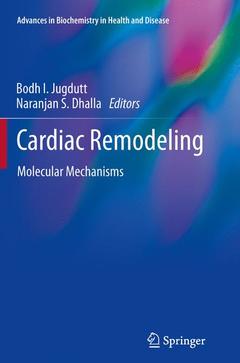Description
Cardiac Remodeling, 2013
Molecular Mechanisms
Advances in Biochemistry in Health and Disease Series, Vol. 5
Coordinators: Jugdutt Bodh I., Dhalla Naranjan S.
Language: English
Subjects for Cardiac Remodeling:
Support: Print on demand
569 p. · 15.5x23.5 cm · Hardback
Description
/li>Contents
/li>Comment
/li>
Part I: Molecular mechanisms of remodeling in pressure and volume overload hypertrophy and ehart failure.- β-adrenergic receptor signaling pathway in heart failure.- Remodeling of potassium channels in cardiac hypertrophy.- Role of gender in Ca2+ cycling and cardiac remodeling due to heart failure.- The failing heart: is it an inefficient engine or an engine out of fuel?.- Regulation of cardiac hypertrophic remodeling by the USP15/SLIM1 pathway.- Role of galectin-3 pathways in the pathogenesis of cardiac remodeling and heart failure.- A mitochondriocentric pathway to cardiomyocyte necrosis: an upstream molecular mechanism in myocardial fibrosis.- The ACE2/Ang (1-7) pathway in cardiac remodeling due to pressure-overload.- Local actions of natriuretic peptides and nitric oxide in cardiac remodelling: Implications for therapy.- Modulating G protein-coupled receptors to effect reverse cardiac remodeling.- Role of inflammation and matrix proteinases in cardiac remodeling following stress and injury.- Role of chymase in matrix and myocardial remodeling due to mitral regurgitation. Implications for therapy.- Cardiac remodeling due to aortic regurgitation and mitral regurgitation.- Reducing oxidative stress and manipulating molecular signaling events using resveratrol as a therapy for pathological cardiac hypertrophy.- Angiogenesis, arteriogenesis, and mitochondrial dysfunction.- Part II: Molecular mechanisms of remodeling after myocardial injury and infarction.- Subcellular remodeling and cardiac dysfunction due to ischemia-reperfusion injury.- Role of microRNAs in cardiac hypertrophy and post-infarction remodeling.- Negative regulators of inflammation as endogenous protective mechanisms in post-infarction remodeling.- TLR-dependent pathways and Akt/mTOR/P70S6K pathways in cardiac remodeling after myocardialinfarction.- The STAT3 pathway and downstream mechanisms in cardiac remodeling: Friend or foe.- The role of growth differentiation factor 5 in cardiac repair post myocardial infarction.- Extracellular matrix biomarkers of adverse remodeling after myocardial infarction.- Oxidative stress in cardiac repair and remodeling: Molecular pathways and therapeutic strategies.- Role of SPARC in cardiac extracellular matrix remodeling after myocardial infarction.- Tissue inhibitor of matrix metalloproteinases in the pathogenesis of heart failure syndromes.- Intracellular matrix remodeling and cardiac function in ischemia-reperfusion injury.- Aging and markers of adverse remodeling after myocardial infarction.- Optimizing stem cell therapy for cardiac repair following a myocardial infarction.- Regulation of fibrosis after myocardial infarction. Implications for ventricular remodeling.- The ACE2/Ang-(1-7) pathway in cardiac fibroblasts as a potential target for cardiac remodeling.




